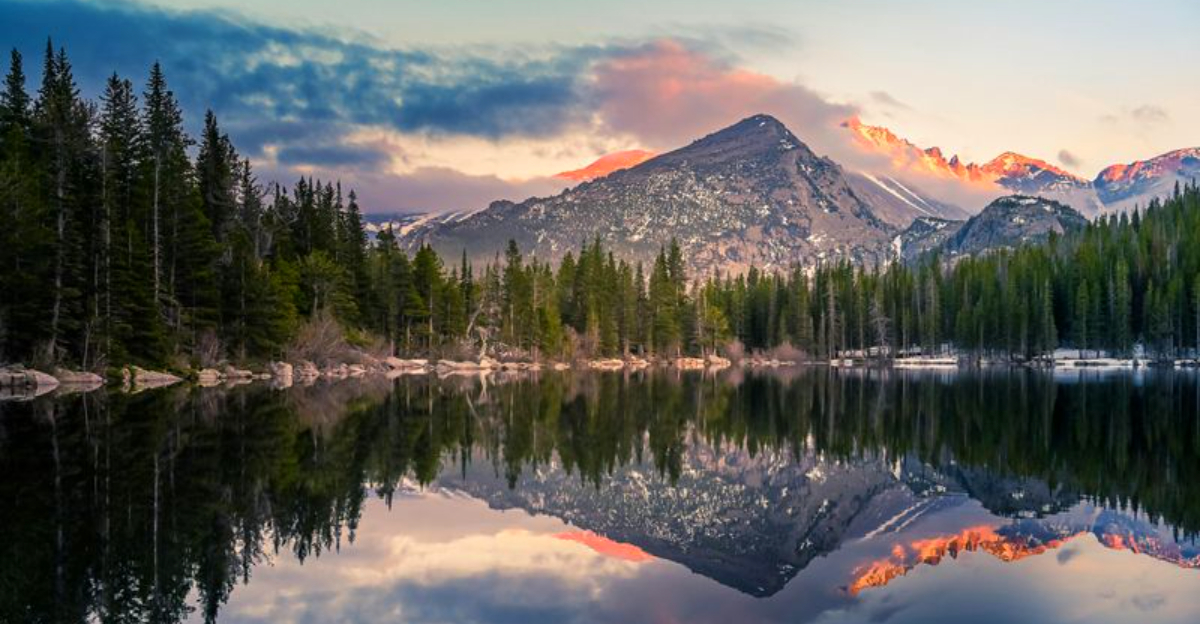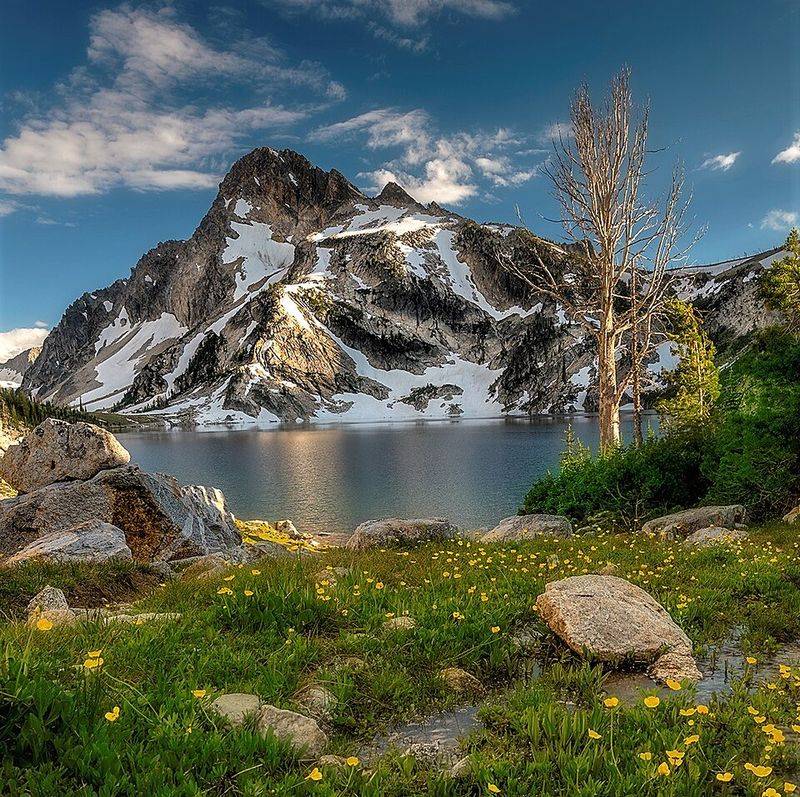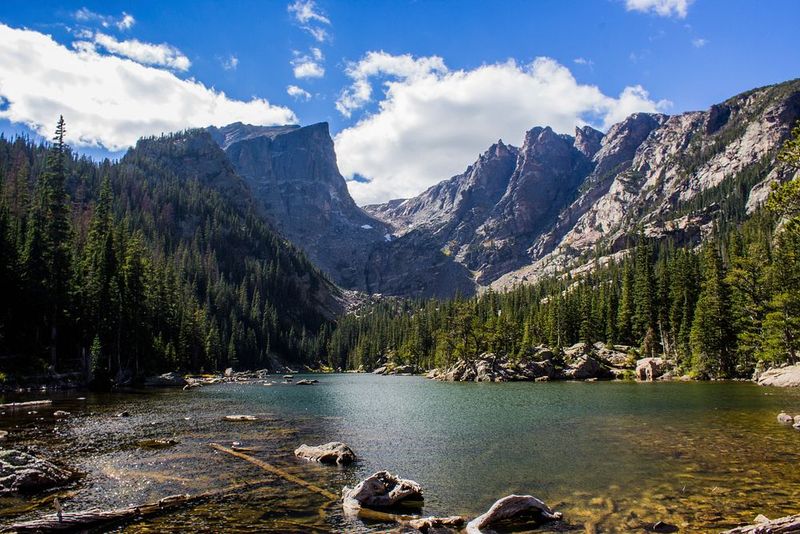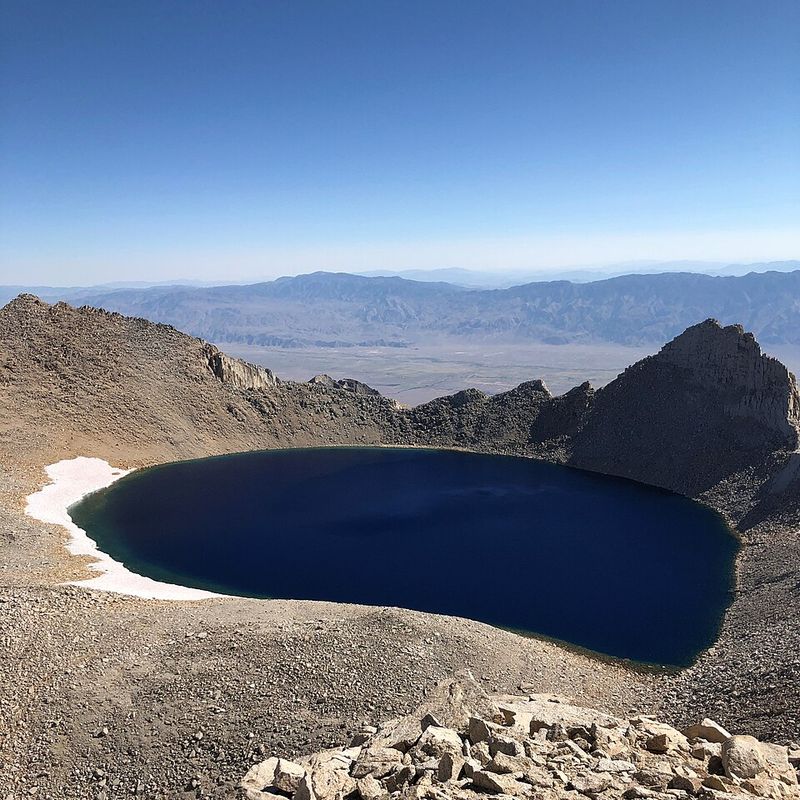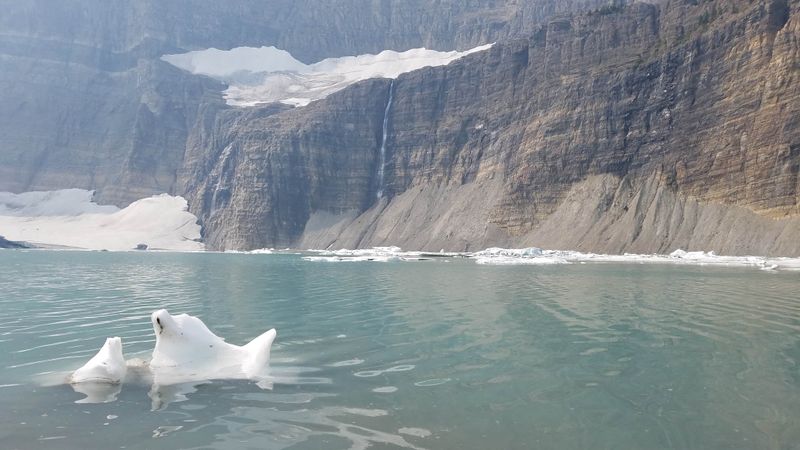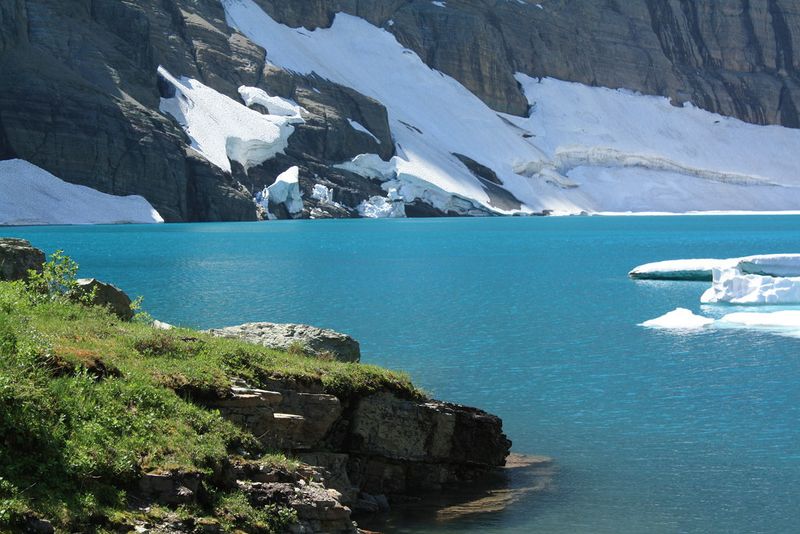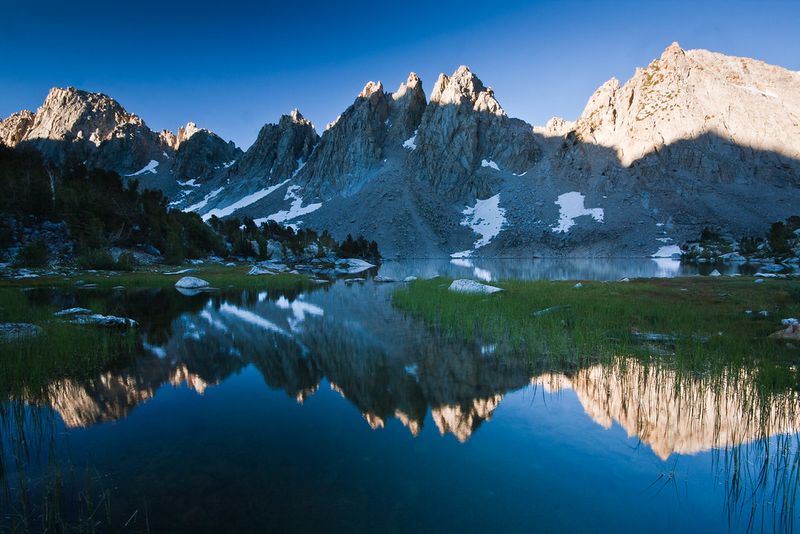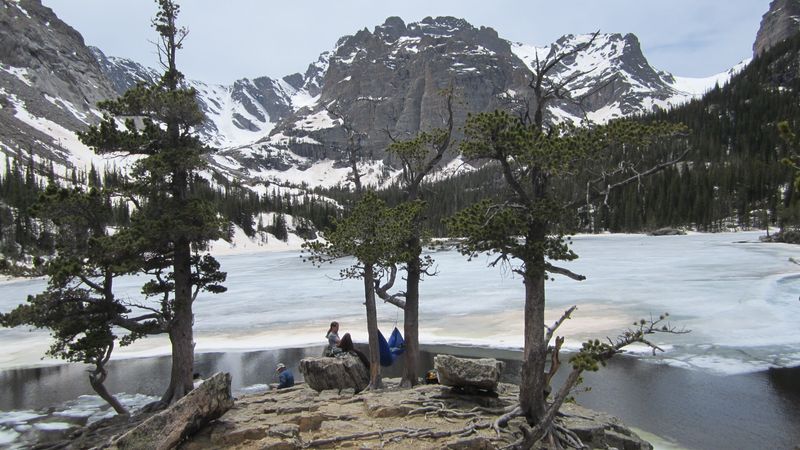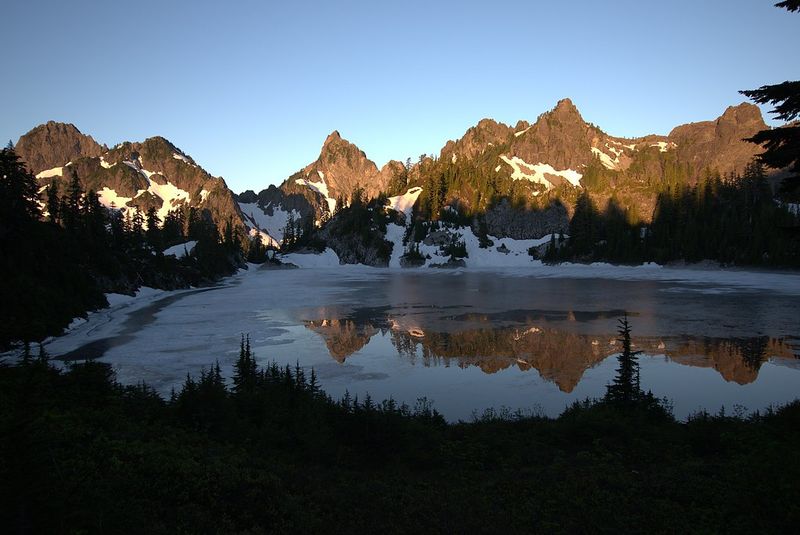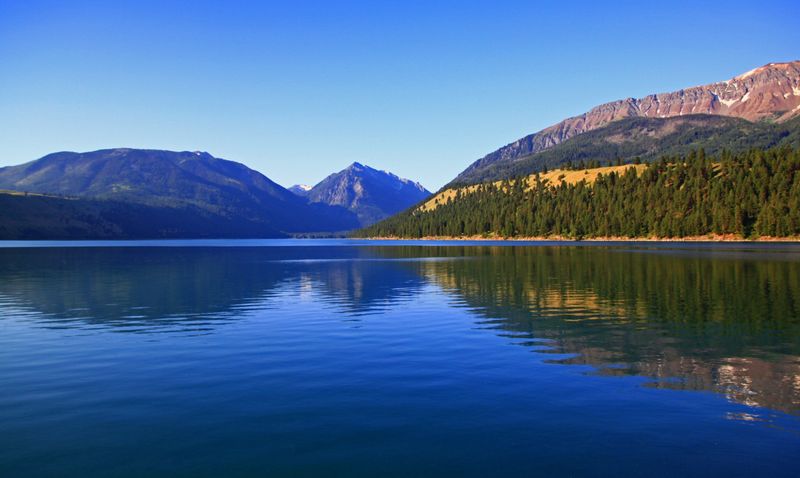America’s alpine lakes are hidden treasures waiting high in the mountains, where crystal-clear water meets dramatic rocky peaks and endless sky. These stunning spots offer hikers and nature lovers a chance to experience some of the most breathtaking scenery in the country. From California’s Sierra Nevada to Montana’s Glacier National Park, each lake has its own special character and beauty. Whether you’re planning your next adventure or just dreaming about wild places, these 16 alpine lakes will inspire you to lace up your hiking boots and hit the trail.
Sawtooth Lake (Idaho)
Glacial water so blue it looks like liquid sky fills this Idaho treasure, nestled at the base of Mount Regan’s dramatic ridges. Hikers who make the journey through Idaho’s Sawtooth Mountains discover a landscape that seems almost too perfect to be real.
The trail winds through alpine meadows bursting with wildflowers before revealing the lake’s mirror-smooth surface. Jagged peaks frame the water on all sides, creating reflections that photographers dream about.
Pack extra memory cards for your camera because every angle offers another postcard-worthy shot. The glacial-fed waters stay cold year-round, but brave swimmers find the experience unforgettable. This remote location rewards those willing to put in the miles with solitude and natural beauty that feels untouched by time.
Lake Blanche (Utah)
Perched nearly 9,000 feet up in Utah’s Wasatch Range, this alpine gem waits at the end of a six-mile trail that climbs through terrain painted with wildflowers. The basin holding Lake Blanche feels like nature’s own cathedral, with granite walls rising on every side.
Spring and early summer bring the best wildflower displays, turning the approach into a colorful parade. The vivid water shifts from deep blue to turquoise depending on the light and time of day.
Many hikers start early to beat afternoon thunderstorms common in these mountains. The elevation gain challenges your legs, but the pristine alpine setting makes every step worthwhile. Bring layers because temperatures at this height can drop quickly, even on sunny days.
Mirror Lake (Colorado)
At roughly 11,000 feet elevation, this Colorado stunner lives up to its name with water so still it doubles the surrounding peaks in perfect reflection. The Rockies tower above, creating a scene that belongs on a postcard.
Fewer crowds make their way to this elevation, meaning you might have the place mostly to yourself on weekdays. The sky-blue water catches light in ways that make you stop and stare, forgetting about the thin air for a moment.
Getting here requires acclimatization to the altitude, so take your time on the approach. The alpine tundra surrounding the lake blooms with tiny flowers in July and August. Pack sunscreen because the sun feels twice as strong at this elevation, and there’s zero shade once you’re above treeline.
Emerald Lake (Colorado)
Rocky Mountain National Park hides this jewel above tree line at about 10,100 feet, where glacier-fed water shimmers in shades of emerald that justify the name perfectly. A moderate hike brings you face-to-face with panoramic mountain views that stretch for miles.
The trail passes two other lakes before reaching Emerald, saving the best for last. Each step upward reveals more of the park’s dramatic landscape, with rocky peaks jutting into impossibly blue skies.
Summer brings the calmest weather, though afternoon thunderstorms can roll in quickly. The alpine environment feels raw and powerful, reminding visitors how small we are compared to these ancient mountains. Wildlife sightings are common, so keep your eyes open for marmots and pikas among the rocks.
Tulainyo Lake (California)
Did you know this ranks among California’s highest named lakes? Tulainyo sits in a glacier-scoured granite bowl near Mount Whitney, offering altitudinous beauty that few other places can match.
The remoteness keeps crowds away, meaning serious hikers willing to tackle the elevation gain get rewarded with solitude. Granite surrounds the lake on all sides, polished smooth by ancient ice that carved these mountains.
Getting here demands excellent physical conditioning and careful planning for high-altitude conditions. The Sierra Nevada shows off its most dramatic side at this elevation, where weather can change from sunny to stormy in minutes. Bring extra layers and rain gear no matter how clear the morning looks. The views from this height make you feel like you’re standing on top of California.
Tenaya Lake (California)
Yosemite National Park showcases this accessible alpine beauty, where granite domes, pine forests, and snow-melt streams create a scene straight from a nature documentary. Unlike some remote alpine lakes, Tenaya welcomes visitors with relatively easy access.
The combination of high-alpine serenity and convenience makes this spot popular with families and photographers alike. Granite formations surrounding the water glow golden during sunrise and sunset, creating magical lighting conditions.
Summer brings warmer water temperatures that actually allow swimming, though it’s still bracing cold. The lake sits along Tioga Road, making it a perfect stop during a Yosemite road trip. Pack a picnic and spend a few hours soaking in views that have inspired artists and adventurers for generations. Early morning visits offer the calmest water and best reflections.
Redfish Lake (Idaho)
Though more famous than some backcountry hideaways, Redfish Lake still delivers spectacular views that stop you in your tracks. Turquoise glacial waters stretch out beneath a mountain amphitheater that defines the Sawtooth range.
The name comes from sockeye salmon that once turned the lake red during spawning season, though their numbers have declined over the years. Hiking trails branch out from the shore, leading to even more secluded basins for those craving deeper wilderness.
Campgrounds and lodges make this lake more accessible for families or those not ready for full backcountry camping. The water stays cold year-round, but kayakers and paddleboarders brave it anyway for the incredible views. Sunset paints the surrounding peaks in shades of pink and orange that reflect off the glassy surface beautifully.
Dusy Basin Lakes (California)
A whole chain of alpine lakes awaits in the eastern Sierra, where the John Muir and Kings Canyon wilderness areas protect some of California’s wildest terrain. High-elevation trails lead adventurers into this basin where solitude comes standard.
Each lake in the chain has its own personality, from shallow and turquoise to deep and sapphire blue. The granite landscape feels ancient and untouched, with peaks that have watched over these waters for millions of years.
Backpackers love this area for multi-day trips, camping beside different lakes each night. The remoteness means you need solid wilderness skills and proper permits before heading out. Wildlife thrives here, including black bears, so proper food storage is essential. The beauty and isolation make every ounce carried on your back worth the effort.
Upper Grinnell Lake (Montana)
Icebergs floating in summer? Yes, really! Upper Grinnell Lake in Glacier National Park offers this surreal sight, where chunks of ancient ice bob in glacier-fed water beneath sheer cliffs.
The lake sits in one of the park’s most dramatic settings, with walls of rock rising hundreds of feet straight up. The cold-blue color of the water comes from glacial flour, tiny particles of rock ground down by moving ice.
Getting here requires a challenging hike, but the otherworldly landscape makes every switchback worthwhile. Bring binoculars to spot mountain goats on the cliffs above, often visible as white specks against the rock. The glacier feeding this lake has shrunk dramatically in recent decades, making each visit feel precious. Photography opportunities abound, especially when icebergs drift past wildflower-dotted shores.
Iceberg Lake (Montana)
Another Glacier National Park wonder, Iceberg Lake earns its name honestly with ice-melt that adds vivid cold-blue hues and a chill that hits you from yards away. Three sides of towering cliffs create an amphitheater that holds the lake like a precious stone.
Even in July and August, ice chunks float in the water, remnants of the massive snowpack that accumulates here each winter. The cliffs trap cold air, keeping temperatures low enough to preserve ice long into summer.
The hike in passes through bear country, so hiking groups and bear spray are smart choices. Wildlife sightings are common, including grizzlies, bighorn sheep, and mountain goats. The incredible frame of rock around the water creates an intimate feeling despite the massive scale. Pack warm layers because the temperature drops noticeably as you approach the lake basin.
Seven Lakes Basin (Washington)
The Olympic Mountains hide this cluster of alpine treasures, where each lake offers its own slice of high-elevation paradise. Ridge and peak views surround the basin, creating scenery that few people ever witness.
Getting to all seven lakes makes for an epic day hike or leisurely overnight trip. The terrain shifts from forested approaches to open alpine meadows dotted with wildflowers in season.
Each lake reflects the surrounding peaks differently, giving photographers endless compositions to explore. The remoteness of the Olympics means these lakes see fewer visitors than similar spots in the Cascades or Rockies. Weather can be unpredictable, with Pacific storms rolling in quickly even during summer. The solitude and wild beauty make the Olympic Mountains feel like a secret that only dedicated hikers discover. Camping permits are required for overnight stays in this popular basin.
Lake Solitude (Wyoming)
Wyoming’s wilderness areas hold several alpine gems called Solitude, and each lives up to the peaceful name perfectly. Whether in the Tetons or Wind Rivers, these remote high-elevation lakes offer alpine calm that soothes the soul.
Jagged peaks frame the water, creating drama that contrasts beautifully with the lake’s peaceful surface. The rugged terrain keeps casual visitors away, reserving these spots for committed hikers willing to earn their views.
Reaching any Lake Solitude requires planning, proper gear, and respect for Wyoming’s unpredictable mountain weather. Afternoon thunderstorms are common in summer, so early starts are wise. The isolation means you might not see another person for hours or even days. Wildlife thrives in these remote areas, including moose, elk, and occasional grizzly bears. The name Solitude isn’t just poetic—it’s a promise of peace away from crowds.
Kearsarge Lakes (California)
Pinnacles rising like stone fingers point skyward above these Sierra high-route destinations, where demanding trails lead to rewards that exceed expectations. The Kearsarge Pinnacles create a backdrop so dramatic it hardly seems real.
Multiple lakes dot the basin, each offering different perspectives on the surrounding granite peaks. The high-route location means serious elevation gain and thin air that tests your lungs.
Backpackers often use this area as a base for exploring deeper into the Sierra backcountry. The crystal-clear water and stark granite landscape create a minimalist beauty that appeals to photographers and nature lovers alike. Summer brings the best conditions, though afternoon thunderstorms can develop quickly. Proper acclimatization to the altitude makes the experience much more enjoyable. The challenging access keeps crowds manageable, even during peak season, rewarding those who make the effort.
Chasm Lake (Colorado)
Longs Peak towers above this high alpine gem, casting shadows across water that sits in a glacier-carved bowl. Rocky Mountain National Park saves some of its most dramatic scenery for those willing to tackle the steep trail to Chasm Lake.
The approach gains elevation quickly, testing your fitness and determination. But reaching the lake feels like stepping into a mountain sanctuary where rock and water meet sky.
Early season brings snow and ice that linger on the trail, requiring extra caution and possibly microspikes. The massive east face of Longs Peak dominates the view, making you feel tiny against the ancient rock. Afternoon weather can turn nasty fast at this elevation, so morning starts are strongly recommended. The raw alpine environment strips away everything unnecessary, leaving only stone, water, and sky in their purest forms.
Gem Lake (Washington)
Small but radiant, this Cascade treasure glows like its name suggests, tucked into a granite amphitheater near Snoqualmie. The lake may not be the biggest, but what it lacks in size it makes up for in pure alpine charm.
Accessibility makes Gem Lake popular with hikers looking for high-alpine vibes without extreme difficulty. The granite walls surrounding the pool create an intimate setting that feels protected and special.
The trail approaches through forest before breaking into open rock near the lake basin. Wildflowers bloom in cracks and crevices where soil has accumulated over centuries. The water reflects the sky in shades of blue and turquoise that change throughout the day. Despite being more accessible than some alpine lakes, Gem still offers solitude on weekdays. Pack a lunch and spend time absorbing the peaceful energy of this mountain hideaway.
Wallowa Lake (Oregon)
Oregon’s Wallowa Mountains cradle this scenic beauty, where steep peaks and glacier history create a landscape that rivals any alpine setting in the country. Though not the highest elevation lake on this list, Wallowa Lake’s dramatic setting earns it a well-deserved spot.
The lake stretches for miles, reflecting mountains that rise steeply from the water’s edge. Glaciers carved this valley during the ice ages, leaving behind a textbook example of glacial geology.
The area offers camping, hiking, and a tramway that lifts visitors to high viewpoints for panoramic vistas. Summer brings warm weather that makes the water temperature almost comfortable for swimming. The Wallowa range, sometimes called the Alps of Oregon, delivers scenery that surprises first-time visitors with its grandeur. Local wildlife includes elk, black bears, and mountain goats that navigate the steep terrain with ease.
